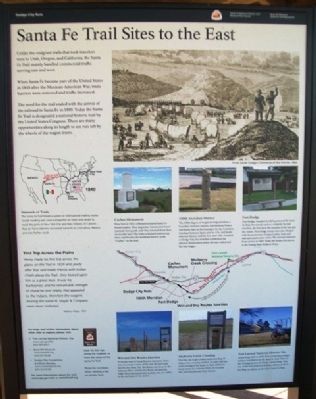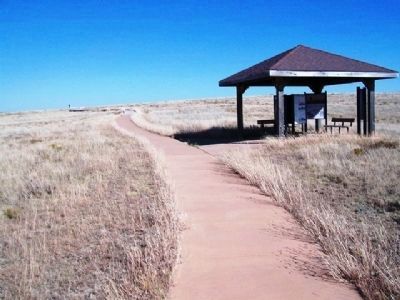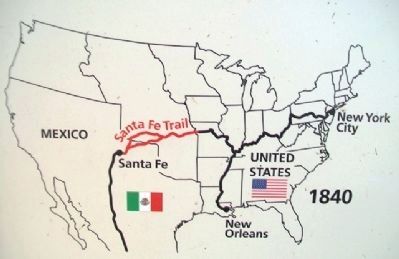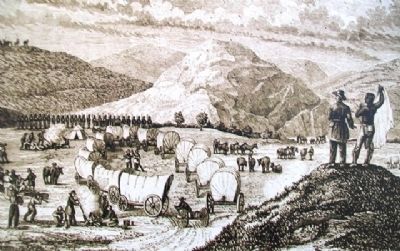Near Howell in Ford County, Kansas — The American Midwest (Upper Plains)
Santa Fe Trail Sites to the East
Unlike the emigrant trails that took travelers west to Utah, Oregon, and California, the Santa Fe Trail mainly handled commercial traffic moving east and west.
When Santa Fe became part of the United States in 1848 after the Mexican-American War, trade barriers were removed and traffic increased.
The need for the trail ended with the arrival of the railroad in Santa Fe in 1880. Today the Santa Fe Trail is designated a national historic trail by the United States Congress. There are many opportunities along its length to see ruts left by the wheels of the wagon trains.
Network of Trade
The Santa Fe Trail linked a system of international trading routes. Goods heading east were transported on rivers and canals to reach the ports of New York City and New Orleans. El Camino Real de Tierra Adentro connected Santa Fe to Chihuahua, Mexico, and sites farther south.
First Trip Across the Plains
Henry made his first trip across the plains on the Trail in 1838 and yearly after that and made friends with Indian Chiefs along the Trail...they looked upon him as a great man. It was his fearlessness and his remarkable strength of character and vitality that appealed to the Indians, therefore the wagons bearing the name H. Mayer & Company were never molested.
Rebecca Mayer, 1852
Caches Monument
Near here in 1822, a blizzard stopped Santa Fe-bound traders. They dug holes, buried, and stored (cached) their goods until they returned from Taos six months later. The holes remained until recent times and became the landmark known as the "Caches" on the trail.
100th Meridian Marker
The 100th degree of longitude long served as a boundary between nations: first between France and Spain; later as the boundary for the Louisiana Purchase between Spain and the U.S.; and finally between Mexico and the U.S. after 1821. Located in Dodge City, the meridian symbolizes the physical demarcation where the east ended and the west began.
Fort Dodge
Fort Dodge, founded in 1865, protected the Santa Fe Trail. Previously used as a campsite by trail travelers, the fort sat at the junction of the wet and dry routes. Fort Dodge troops were also charged with the protection of stagecoaches, mail, and railroad construction crews. The fort was removed from service in 1882. Today the former fort serves as the Kansas State Soldiers Home.
Wet and Dry Routes Junction
From just west of Great Bend to this point, there were two major routes of the trail, the wet route and the dry route. The Wet Route ran closer to the Arkansas River and the Dry Route ran atop the ridge. Here they joined and multiple ruts are visible to the northeast
of the marker.
Mulberry Creek Crossing
Visit this site to get a better understanding of what a river crossing entailed. An early and less used crossing of the Santa Fe Trail, Mulberry Creek meets the Arkansas River on its south side, near present-day Ford, Kansas.
Fort Larned National Historic Site
Active from 1859 to 1878, Fort Larned was a major military installation on the Santa Fe Trail. Nine of the 10 original stone buildings remain today. Visit one of the best preserved frontier military posts in the West, as well as on the entire Santa Fe Trail.
Erected by National Park Service, Boot Hill Museum, and Santa Fe Trail Association.
Topics and series. This historical marker is listed in these topic lists: Forts and Castles • Industry & Commerce • Roads & Vehicles. In addition, it is included in the Santa Fe Trail series list. A significant historical year for this entry is 1848.
Location. 37° 47.387′ N, 100° 11.828′ W. Marker is near Howell, Kansas, in Ford County. Trail Ruts Park is on the right while traveling west of US Hwy 50/400, about ½ mile west of Howell Road. Touch for map. Marker is in this post office area: Dodge City KS 67801, United States of America. Touch for directions.
Other nearby markers. At least 8 other markers are within walking distance of this marker. Trails on the Prairie (here, next to this marker); Santa Fe Trail Sites to the West & South (here, next to this marker); A Fine Country… (here, next to this marker); Santa Fe Trail, 1821 - 1880 (here, next to this marker); Campsite of the U.S. Survey Team Sept. 10-21, 1825 (within shouting distance of this marker); a different marker also named Santa Fe Trail (within shouting distance of this marker); The Worst Piece of Road (about 400 feet away, measured in a direct line); Santa Fe Trail Remains (about 500 feet away). Touch for a list and map of all markers in Howell.
Also see . . .
1. Santa Fe National Historic Trail. (Submitted on May 26, 2013, by William Fischer, Jr. of Scranton, Pennsylvania.)
2. Santa Fe Trail Association. (Submitted on May 26, 2013, by William Fischer, Jr. of Scranton, Pennsylvania.)
Credits. This page was last revised on September 2, 2020. It was originally submitted on May 26, 2013, by William Fischer, Jr. of Scranton, Pennsylvania. This page has been viewed 769 times since then and 62 times this year. Photos: 1, 2, 3, 4. submitted on May 26, 2013, by William Fischer, Jr. of Scranton, Pennsylvania.



